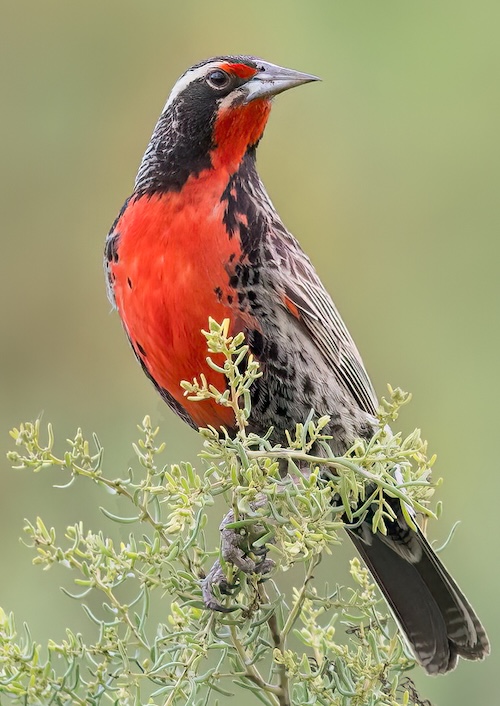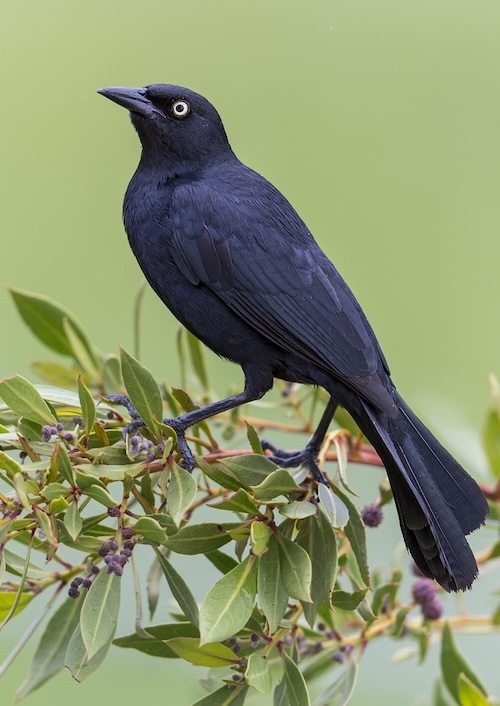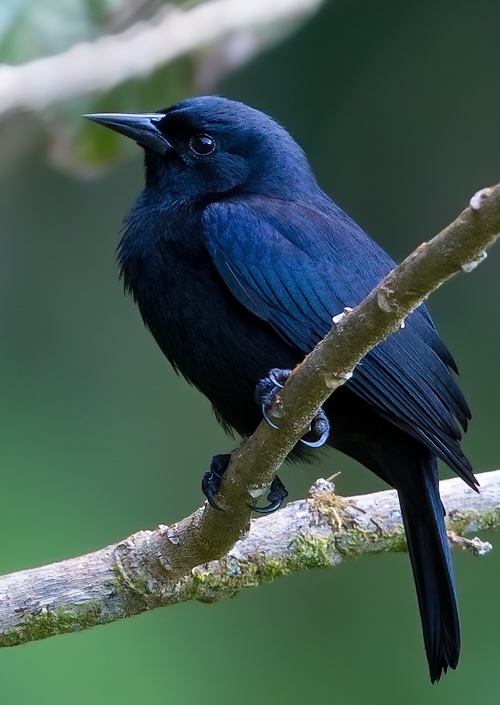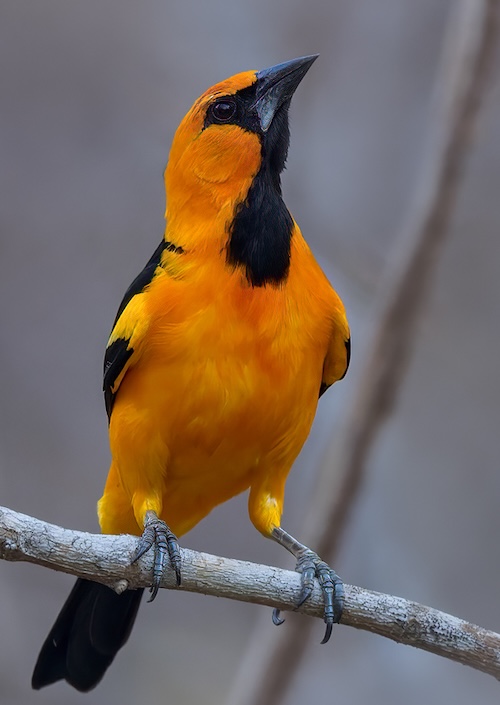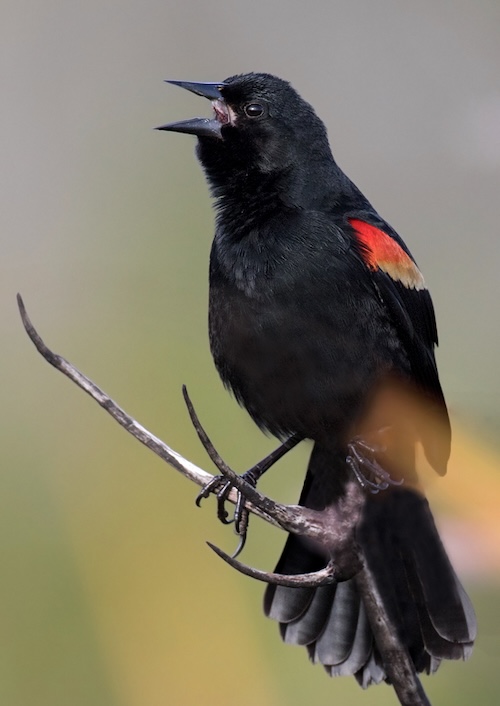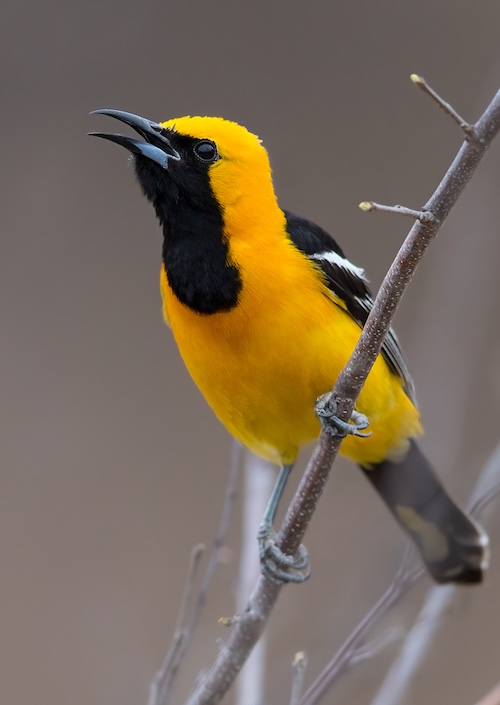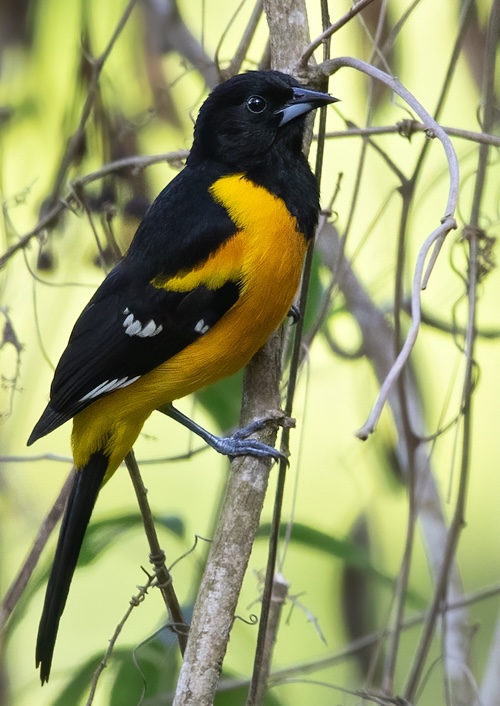Icteridae – Oropendolas, Orioles, Blackbirds & Allies
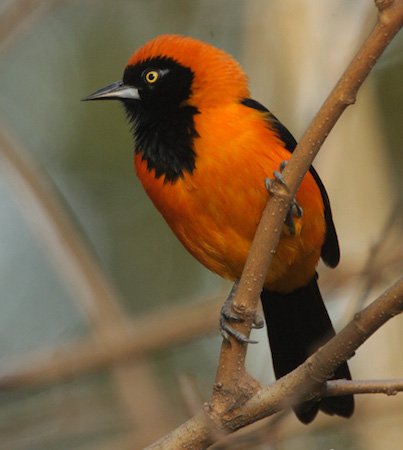
The Grackle
by Ogden Nash
The grackle’s voice is less than mellow,
His heart is black, his eye is yellow,
He bullies more attractive birds
With hoodlum deeds and vulgar words,
And should a human interfere,
Attacks that human in the rear.
I cannot help but deem the grackle
An ornithological debacle.
The Icteridae (Orioles, Oropendolas, Blackbirds & Allies) are a large family of small- to medium-sized, often colourful, New-World passerines. Most species have black as a predominant plumage colour, often enlivened by yellow, orange or red. The family is widely varied in size, shape, behaviour and coloration.
|
|
|
|
Long-tailed Meadowlark Leistes loyca |
Greater Antillean Grackle Quiscalus niger |
|
|
|
|
Bobolink Dolichonyx oryzivorus |
Jamaican Blackbird Nesopsar nigerrimus |
|
All photos in this text courtesy of ©Dubi Shapiro |
|
The name, meaning ‘jaundiced ones’ (from the prominent yellow feathers of many species) comes from the Ancient Greek ikteros via the Latin ictericus. This group includes the New World blackbirds, New World orioles, the bobolink, meadowlarks, grackles, cowbirds, oropendolas and caciques.
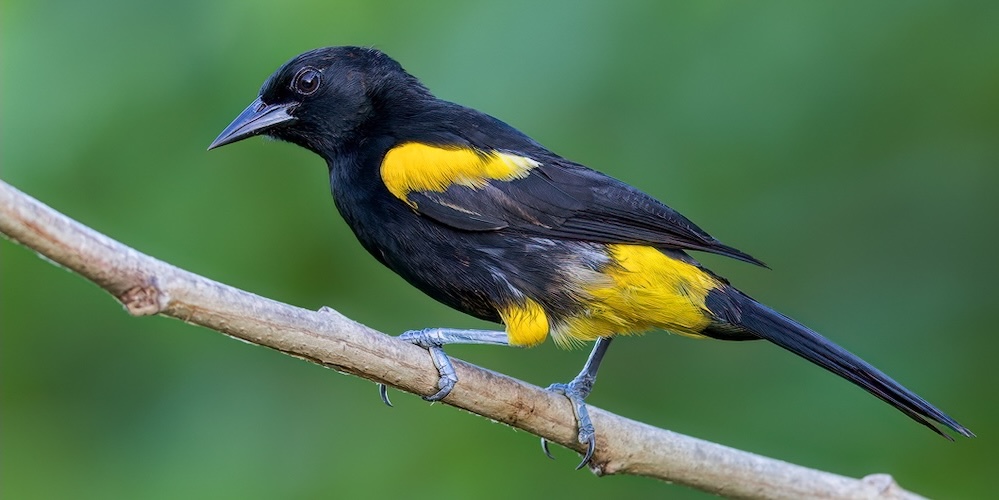
Puerto Rican Oriole Icterus portoricensis
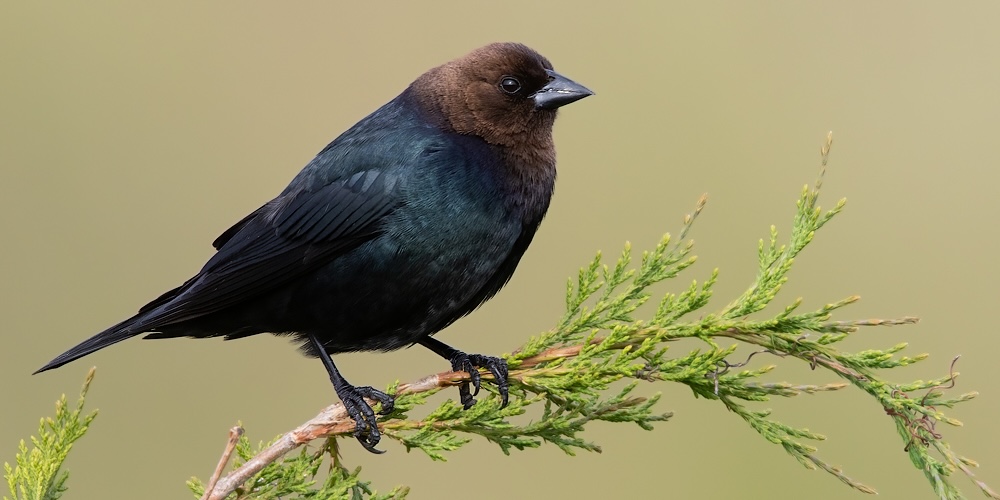 Brown-headed Cowbird Molothrus ater
Brown-headed Cowbird Molothrus ater
Despite the similar names, New-World blackbirds are only distantly related to the Old-World Blackbird (a thrush) or New-World orioles to the Old-World orioles.
|
|
|
|
Altamira Oriole Icterus gularis |
Red-shouldered Blackbird Agelaius assimilis |
|
|
|
|
Hooded Oriole Icterus cucullatus |
Bar-winged Oriole Icterus maculialatus |
The majority of icterid species live in the tropics, although there are a number of temperate forms, such as American blackbirds and the long-tailed meadowlark. The highest densities of breeding species are found in Colombia and in southern Mexico. They inhabit a range of habitats, including scrub, swamp, forest, and savanna. The temperate species are migratory, with many species that nest in the United States and Canada moving south into Mexico and Central America.
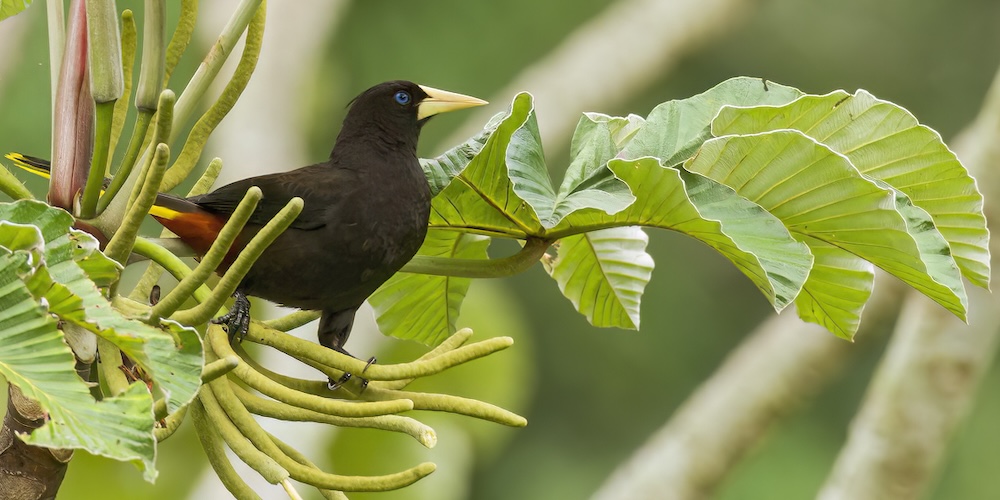
Crested Oropendola Psarocolius decumanus
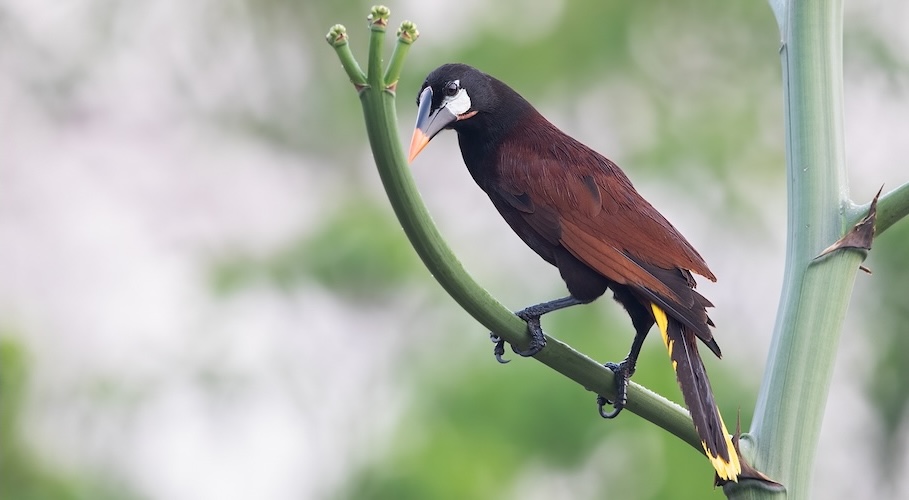
Montezuma Oropendola Psarocolius montezuma
Icterids are variable in size, and often display considerable sexual dimorphism, with brighter coloration and greater size in males being typical. While such dimorphism is widely known in passerines, the sexual dimorphism by size is uniquely extreme in icterids. For example, the male Great-tailed Grackle is 60% heavier than the female. The smallest icterid species is the Orchard Oriole, in which the female averages 15 cm in length and 18 grams in weight, while the largest is the Amazonian Oropendola, the male of which measures 52 cm and weighs about 550 grams. This variation is greater than in any other passerine family. Most icterids have rounded tails and lack rictal bristles. They have nine primary feathers and are placed among the nine-primaried oscines.
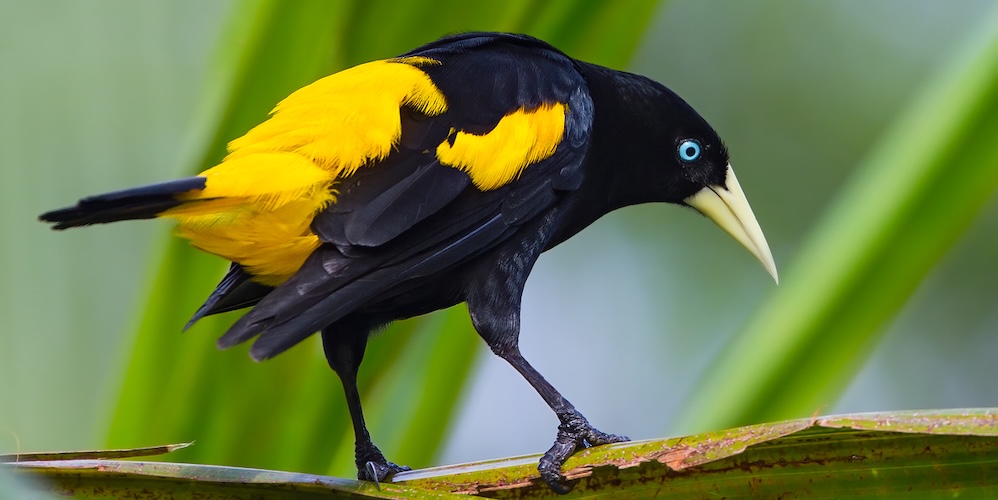
Yellow-rumped Cacique Cacicus cela
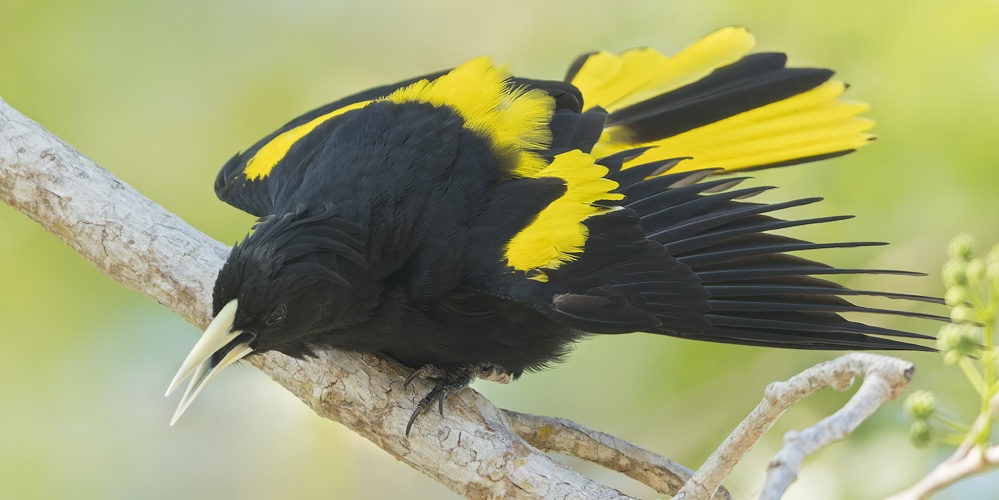
Mexican Cacique Cassiculus melanicterus
One unusual morphological adaptation shared by the icterids is gaping, where the skull is configured to allow them to open their bills strongly rather than passively, allowing them to force open gaps to obtain otherwise hidden food. Icterids have adapted to taking a wide range of foods. Oropendolas and caciques use their gaping motion to open the skins of fruit to obtain the soft insides, and have long bills adapted to the process. Others such as cowbirds and the bobolink have shorter stubbier bills for crushing seeds. The Jamaican blackbird uses its bill to pry amongst tree bark and epiphytes, and has adopted the evolutionary niche filled elsewhere in the Neotropics by woodcreepers. Orioles will drink nectar.
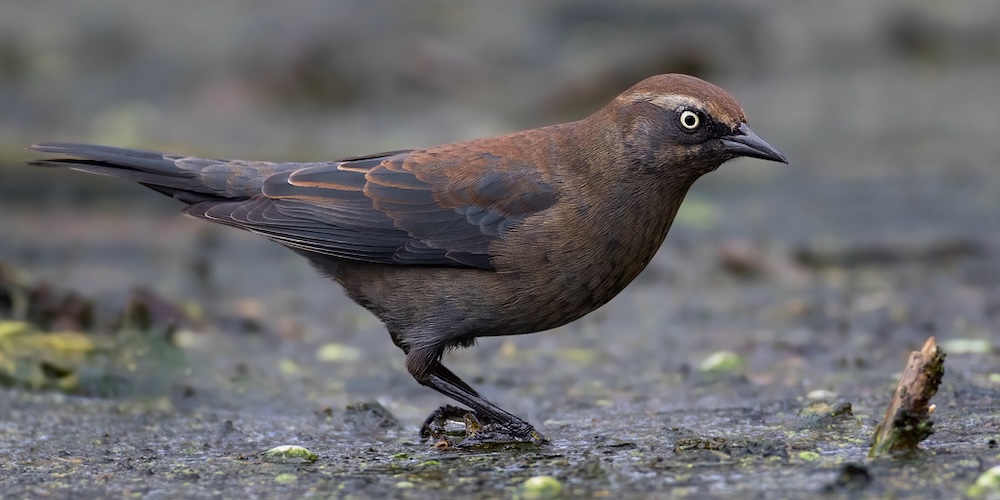
Rusty Blackbird Euphagus carolinus
The nesting habits of these birds are similarly variable, including pendulous woven nests in the oropendolas and orioles. Many icterids are colonial, nesting in colonies of up to 100,000 birds. Some cowbird species engage in brood parasitism: females lay their eggs in the nests of other species, in a similar fashion to some cuckoos.
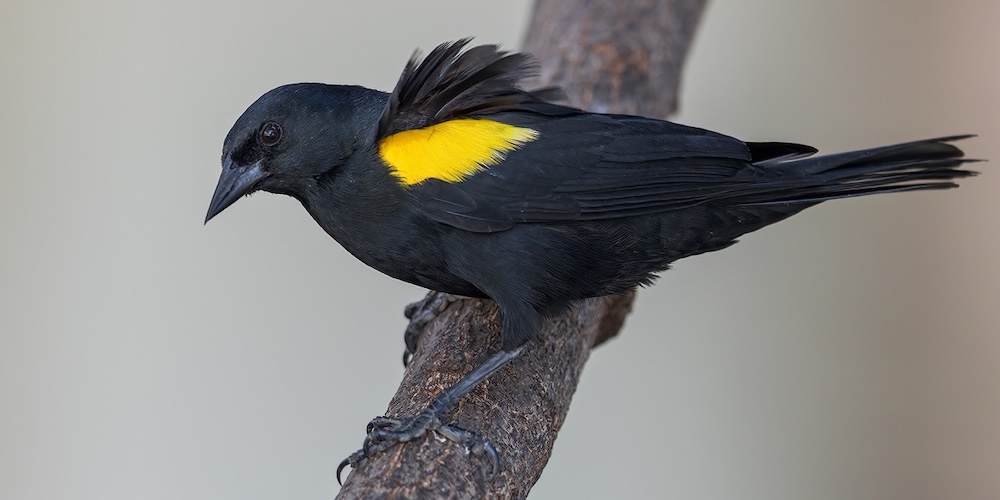
Yellow-shouldered Blackbird Agelaius xanthomus
Not all species have been successful in adapting to human habitat changes, and a number of species are threatened with extinction. These include a number of insular forms such as the Jamaican Blackbird, Yellow-shouldered Blackbird, and the St Lucia Oriole, which are threatened by habitat loss, and the Tricolored Blackbird of California, which is threatened by habitat loss and destruction of nests.
-
Number of bird species: 108
(As at October 2025)
According to the recently (2025) amalgamated AviList there are one hundred and eight species in thirty-one genera in the Icteridae family of New World Orioles, New World Blackbirds, Grackles, Cowbirds, Meadowlarks, Oropendolas, & Caciques. They are:
Yellow-breasted Chat Icteria virens
Yellow-headed Blackbird Xanthocephalus xanthocephalus
Bobolink Dolichonyx oryzivorus
Western Meadowlark Sturnella neglecta
Eastern Meadowlark Sturnella magna
Chihuahuan Meadowlark Sturnella lilianae
Red-breasted Blackbird Leistes militaris
White-browed Blackbird Leistes superciliaris
Peruvian Meadowlark Leistes bellicosa
Pampas Meadowlark Leistes defilippii
Long-tailed Meadowlark Leistes loyca
Yellow-billed Cacique Amblycercus holosericeus
Mexican Cacique Cassiculus melanicterus
Russet-backed Oropendola Psarocolius angustifrons
Dusky-green Oropendola Psarocolius atrovirens
Green Oropendola Psarocolius viridis
Crested Oropendola Psarocolius decumanus
Chestnut-headed Oropendola Psarocolius wagleri
Montezuma Oropendola Psarocolius montezuma
Black Oropendola Psarocolius guatimozinus
Baudo Oropendola Psarocolius cassini
Olive Oropendola Psarocolius bifasciatus
Solitary Cacique Cacicus solitarius
Golden-winged Cacique Cacicus chrysopterus
Ecuadorian Cacique Cacicus sclateri
Selva Cacique Cacicus koepckeae
Subtropical Cacique Cacicus uropygialis
Yellow-rumped Cacique Cacicus cela
Southern Mountain Cacique Cacicus chrysonotus
Band-tailed Oropendola Cacicus latirostris
Red-rumped Cacique Cacicus haemorrhous
Casqued Oropendola Cacicus oseryi
Hispaniolan Oriole Icterus dominicensis
Cuban Oriole Icterus melanopsis
Bahama Oriole Icterus northropi
Puerto Rican Oriole Icterus portoricensis
St. Lucia Oriole Icterus laudabilis
Montserrat Oriole Icterus oberi
Martinique Oriole Icterus bonana
Black-vented Oriole Icterus wagleri
Bar-winged Oriole Icterus maculialatus
Black-cowled Oriole Icterus prosthemelas
Orchard Oriole Icterus spurius
Hooded Oriole Icterus cucullatus
Yellow-backed Oriole Icterus chrysater
Orange-crowned Oriole Icterus auricapillus
White-edged Oriole Icterus graceannae
Yellow-tailed Oriole Icterus mesomelas
Epaulet Oriole Icterus cayanensis
Variable Oriole Icterus pyrrhopterus
Venezuelan Troupial Icterus icterus
Campo Troupial Icterus jamacaii
Orange-backed Troupial Icterus croconotus
Streak-backed Oriole Icterus pustulatus
Bullock’s Oriole Icterus bullockiorum
Orange Oriole Icterus auratus
Jamaican Oriole Icterus leucopteryx
Yellow Oriole Icterus nigrogularis
Spot-breasted Oriole Icterus pectoralis
Altamira Oriole Icterus gularis
Audubon’s Oriole Icterus graduacauda
Baltimore Oriole Icterus galbula
Black-backed Oriole Icterus abeillei
Scott’s Oriole Icterus parisorum
Jamaican Blackbird Nesopsar nigerrimus
Red-winged Blackbird Agelaius phoeniceus
Red-shouldered Blackbird Agelaius assimilis
Tricolored Blackbird Agelaius tricolor
Tawny-shouldered Blackbird Agelaius humeralis
Yellow-shouldered Blackbird Agelaius xanthomus
Screaming Cowbird Molothrus rufoaxillaris
Shiny Cowbird Molothrus bonariensis
Bronzed Cowbird Molothrus aeneus
Bronze-brown Cowbird Molothrus armenti
Brown-headed Cowbird Molothrus ater
Giant Cowbird Molothrus oryzivorus
Melodious Blackbird Dives dives
Scrub Blackbird Dives warczewiczi
Cuban Blackbird Ptiloxena atroviolacea
Brewer’s Blackbird Euphagus cyanocephalus
Rusty Blackbird Euphagus carolinus
Common Grackle Quiscalus quiscula
Boat-tailed Grackle Quiscalus major
Great-tailed Grackle Quiscalus mexicanus
Slender-billed Grackle Quiscalus palustris
Nicaraguan Grackle Quiscalus nicaraguensis
Greater Antillean Grackle Quiscalus niger
Carib Grackle Quiscalus lugubris
Colombian Mountain Grackle Macroagelaius subalaris
Golden-tufted Mountain Grackle Macroagelaius imthurni
Velvet-fronted Grackle Lampropsar tanagrinus
Oriole Blackbird Gymnomystax mexicanus
Red-bellied Grackle Hypopyrrhus pyrohypogaster
Scarlet-headed Blackbird Amblyramphus holosericeus
Austral Blackbird Curaeus curaeus
Forbes’s Blackbird Anumara forbesi
Chopi Blackbird Gnorimopsar chopi
Pale-eyed Blackbird Agelasticus xanthophthalmus
Unicolored Blackbird Agelasticus cyanopus
Yellow-winged Blackbird Agelasticus thilius
Bolivian Blackbird Oreopsar bolivianus
Greyish Baywing Agelaioides badius
Pale Baywing Agelaioides fringillarius
Chestnut-capped Blackbird Chrysomus ruficapillus
Yellow-hooded Blackbird Chrysomus icterocephalus
Saffron-cowled Blackbird Xanthopsar flavus
Brown-and-yellow Marshbird Pseudoleistes virescens
Yellow-rumped Marshbird Pseudoleistes guirahuro
-
New World Blackbirds - The Icterids
| By Alvaro Jaramillo & Peter Burke | Helm | 1999 | Hardback | 432 pages | ISBN: 9780713643336 Buy this book from NHBS.com
-
Icteridae
Family AccountFrom small orioles to the mighty oropendolas, this family spans a broad variation in body size, nesting ecology, and mating systems. -
Icteridae
Family AccountIcterids or New World blackbirds make up a family, the Icteridae of small to medium-sized, often colorful, New World passerine birds.
Given the number of species in this family, Fatbirder does not provide quick links to all of them. However, the entries below do include links to representatives of every genera, all those illustrated and some of the most often encountered, iconic or sought-after species.
-
Altamira Oriole Icterus gularis
Species AccountThe Altamira oriole (Icterus gularis) is a New World oriole. -
Altamira Oriole Icterus gularis
Species AccountSound archive and distribution map -
Austral Blackbird Curaeus curaeus
Species AccountThe austral blackbird (Curaeus curaeus) is a species of bird in the family Icteridae. It is found in Argentina and Chile. Its natural habitats are temperate forests, subtropical or tropical high-altitude shrubland, and heavily degraded former forest. -
Austral Blackbird Curaeus curaeus
Species AccountSound archive and distribution map -
Bar-winged Oriole Icterus maculialatus
Species AccountVery local, poorly known black-and-yellow oriole of Chiapas and northern Central America. -
Bar-winged Oriole Icterus maculialatus
Species AccountSound archive and distribution map -
Boat-tailed Grackle Quiscalus major
Species AccountThe boat-tailed grackle (Quiscalus major) is a passerine bird of the family Icteridae found as a permanent resident on the coasts of the southeastern United States. It is found in coastal saltwater marshes, and, in Florida, also on inland waters. The nest is a well-concealed cup in trees or shrubs near water; three to five eggs are laid. -
Boat-tailed Grackle Quiscalus major
Species AccountSound archive and distribution map -
Bobolink Dolichonyx oryzivorus
Species AccountBreeding male is distinctive with black body, white rump, and creamy nape. -
Bobolink Dolichonyx oryzivorus
Species AccountSound archive and distribution map -
Bolivian Blackbird Oreopsar bolivianus
Species AccountThe Bolivian blackbird (Oreopsar bolivianus) is a species of bird in the family Icteridae. -
Bolivian Blackbird Oreopsar bolivianus
Species AccountSound archive and distribution map -
Brewer's Blackbird Euphagus cyanocephalus
Species AccountBrewer's blackbird (Euphagus cyanocephalus) is a medium-sized New World blackbird. -
Brewer's Blackbird Euphagus cyanocephalus
Species AccountSound archive and distribution map -
Brown-headed Cowbird Molothrus ater
Species AccountShort tail and stocky body. Males are glossy black with chocolate brown head. Females are gray-brown overall, without bold streaks, but slightly paler throat. -
Brown-headed Cowbird Molothrus ater
Species AccountSound archive and distribution map -
Chopi Blackbird Gnorimopsar chopi
Species AccountThe chopi blackbird (Gnorimopsar chopi) is a South American songbird species in the family Icteridae. -
Chopi Blackbird Gnorimopsar chopi
Species AccountSound archive and distribution map -
Common Grackle Quiscalus quiscula
Species AccountThe common grackle (Quiscalus quiscula) is a large icterid which is found in large numbers through much of North America. -
Common Grackle Quiscalus quiscula
Species AccountQuiscalus quiscula is listed as Near Threatened under criteria A4ad. -
Common Grackle Quiscalus quiscula
Species AccountSound archive and distribution map -
Crested Oropendola Psarocolius decumanus
Species AccountThe crested oropendola also known as the Suriname crested oropendola or the cornbird (Psarocolius decumanus) is a New World tropical icterid bird. It is a resident breeder in lowland South America east of the Andes, from Panama and Colombia south to northern Argentina, as well as on Trinidad and Tobago. If the genus Gymnostinax for the Montezuma oropendola and its closest relatives were considered valid, this species would probably belong in that genus (Price & Lanyon 2002). -
Crested Oropendola Psarocolius decumanus
Species AccountSound archive and distribution map -
Cuban Blackbird Ptiloxena atroviolacea
Species AccountThe Cuban blackbird (Ptiloxena atroviolacea) is a species of bird in the family Icteridae. -
Cuban Blackbird Ptiloxena atroviolacea
Species AccountSound archive and distribution map -
Forbes's Blackbird Anumara forbesi
Species AccountMedium-sized, slim blackbird with uniform matte black plumage. -
Forbes's Blackbird Anumara forbesi
Species AccountSound archive and distribution map -
Golden-tufted Mountain Grackle Macroagelaius imthurni
Species AccountA medium-sized blackbird of tepui highland forests. -
Golden-tufted Mountain Grackle Macroagelaius imthurni
Species AccountSound archive and distribution map -
Great-tailed Grackle Quiscalus mexicanus
Species AccountThe great-tailed grackle or Mexican grackle (Quiscalus mexicanus) is a medium-sized, highly social passerine bird native to North and South America. A member of the family Icteridae, it is one of ten extant species of grackle and is closely related to the boat-tailed grackle and the slender-billed grackle. -
Great-tailed Grackle Quiscalus mexicanus
Species AccountQuiscalus mexicanus is listed as Least Concern. -
Great-tailed Grackle Quiscalus mexicanus
Species AccountSound archive and distribution map -
Greater Antillean Grackle Quiscalus niger
Species AccountA gregarious, noisy inhabitant of many habitats, except dense woodlands; often near human habitation. -
Greater Antillean Grackle Quiscalus niger
Species AccountSound archive and distribution map -
Greyish Baywing Agelaioides badius
Species AccountA medium-sized blackbird with a short bill. -
Greyish Baywing Agelaioides badius
Species AccountSound archive and distribution map -
Hooded Oriole Icterus cucullatus
Species AccountSound archive and distribution map -
Hooded Oriole Icterus cucullatus
Species AccountSound archive and distribution map -
Hooded Oriole Icterus cucullatus
Species AccountThe hooded oriole (Icterus cucullatus) is a medium-sized New World oriole. -
Hooded Oriole Icterus cucullatus
Species AccountAdults have a curved bill which is completely black and white wing bars. The adult male has a deep yellowish orange head with black on the face and throat; they are black on the back, wings and tail, orange on the underparts. The adult female is olive-green on the upper parts, yellowish on the breast and belly. Their calls consist of whistling and wheets, while their song is a mixture of both. -
Jamaican Blackbird Nesopsar nigerrimus
Species AccountThe Jamaican blackbird (Nesopsar nigerrimus) is a species of bird in the New World blackbird and oriole family Icteridae. -
Jamaican Blackbird Nesopsar nigerrimus
Species AccountSound archive and distribution map -
Long-tailed Meadowlark Leistes loyca
Species AccountThe long-tailed meadowlark (Leistes loyca) is a passerine bird of southern South America and the Falkland Islands, belonging to the meadowlark genus Leistes. -
Long-tailed Meadowlark Leistes loyca
Species AccountSound archive and distribution map -
Melodious Blackbird Dives dives
Species AccountFairly common in semi-open habitats of tropical lowlands, usually in pairs or small groups. -
Melodious Blackbird Dives dives
Species AccountSound archive and distribution map -
Mexican Cacique Cassiculus melanicterus
Species AccountSpectacular and conspicuous black-and-yellow bird of tropical lowlands in west Mexico. -
Mexican Cacique Cassiculus melanicterus
Species AccountSound archive and distribution map -
Montezuma Oropendolas Gymnostinops montezuma
Species AccountSound archive and distribution map -
Montezuma Oropendolas Gymnostinops montezuma
Species AccountThe Montezuma oropendola (Psarocolius montezuma) is a New World tropical icterid bird. It is a resident breeder in the Caribbean coastal lowlands from southeastern Mexico to central Panama, but is absent from El Salvador and southern Guatemala. -
Montserrat Oriole Icterus oberi
Species AccountIcterus oberi is listed as Vulnerable under criteria D1+2. -
Montserrat Oriole Icterus oberi
Species AccountSound archive and distribution map -
Montserrat Oriole Icterus oberi
Species AccountThe Montserrat Oriole (Icterus oberi) is a medium-sized black-and-yellow icterid (the same family as many blackbirds, meadowlarks, cowbirds, grackles, and others, including the New World orioles). -
Orange-backed (Oriole) Troupial Icterus croconotus
Species AccountThe orange-backed troupial (Icterus croconotus) is a species of bird in the family Icteridae. -
Orange-backed (Oriole) Troupial Icterus croconotus
Species AccountSound archive and distribution map -
Oriole Blackbird Gymnomystax mexicanus
Species AccountThe oriole blackbird (Gymnomystax mexicanus) is a species of bird in the family Icteridae. -
Oriole Blackbird Gymnomystax mexicanus
Species AccountSound archive and distribution map -
Puerto Rican Oriole Icterus portoricensis
Species AccountThe Puerto Rican oriole (Icterus portoricensis), or calandria is a species of bird in the family Icteridae, and genus Icterus or New World blackbirds. -
Puerto Rican Oriole Icterus portoricensis
Species AccountSound archive and distribution map -
Red-bellied Grackle Hypopyrrhus pyrohypogaster
Species AccountThe red-bellied grackle (Hypopyrrhus pyrohypogaster) is a species of bird in the family Icteridae. -
Red-bellied Grackle Hypopyrrhus pyrohypogaster
Species AccountSound archive and distribution map -
Red-breasted Blackbird Leistes militaris
Species AccountSound archive and distribution map -
Red-breasted Blackbird Leistes militaris
Species AccountThe red-breasted meadowlark (Leistes militaris) is a passerine bird in the New World family Icteridae. -
Red-shouldered Blackbird Agelaius assimilis
Species AccountA mostly black inhabitant of swamps and marshes. -
Red-shouldered Blackbird Agelaius assimilis
Species AccountSound archive and distribution map -
Red-winged Blackbird Agelaius phoeniceus
Species AccountThe red-winged blackbird (Agelaius phoeniceus) is a passerine bird of the family Icteridae found in most of North and much of Central America. It breeds from Alaska and Newfoundland south to Florida, the Gulf of Mexico, Mexico, and Guatemala, with isolated populations in western El Salvador, northwestern Honduras, and northwestern Costa Rica. -
Red-winged Blackbird Agelaius phoeniceus
Species AccountSound archive and distribution map -
Russet-backed Oropendola Psarocolius angustifrons
Species AccountGenerally olive overall with warmer rufous tones on back and rump. Variable bill color: dark blackish in the Amazonian lowlands; usually yellowish in Andes. -
Russet-backed Oropendola Psarocolius angustifrons
Species AccountThe russet-backed oropendola (Psarocolius angustifrons) is a species of bird in the family Icteridae. It is found in wooded habitats in the highlands of the northern and central Andes and the Venezuelan Coastal Range, and in lowlands of the western Amazon. It is generally common and widespread. Males are larger than females, but otherwise the genders are similar. Its plumage is mainly olive and brown, and the outer rectrices are contrastingly yellow. The lowland nominate subspecies has a black bill, while the highland subspecies all have pale bills. These have been regarded as separate species, but as they hybridize freely, all major authorities now regard them as a single species. -
Russet-backed Oropendola Psarocolius angustifrons
Species AccountSound archive and distribution map -
Rusty Blackbird Euphagus carolinus
Species AccountRusty edges to feathers and pale eyebrow in winter contrast with blackish feather bases. -
Rusty Blackbird Euphagus carolinus
Species AccountSound archive and distribution map -
Saffron-cowled Blackbird Xanthopsar flavus
Species AccountThe saffron-cowled blackbird (Xanthopsar flavus) is a species of bird in the family Icteridae. -
Saffron-cowled Blackbird Xanthopsar flavus
Species AccountSound archive and distribution map -
Scarlet-headed Blackbird Amblyramphus holosericeus
Species AccountSound archive and distribution map -
Scarlet-headed Blackbird Amblyramphus holosericeus
Species AccountA stunning blackbird with a sharply-pointed bill. -
Scrub Blackbird Dives warczewiczi
Species AccountA conspicuous blackbird of open country in western Ecuador, western Peru, and far southwestern Colombia. -
Scrub Blackbird Dives warczewiczi
Species AccountSound archive and distribution map -
Shiny Cowbird Molothrus bonariensis
Species AccountThe shiny cowbird (Molothrus bonariensis) is a passerine bird in the New World family Icteridae. -
Shiny Cowbird Molothrus bonariensis
Species AccountSound archive and distribution map -
Velvet-fronted Grackle Lampropsar tanagrinus
Species AccountSlim, medium-sized blackbird closely associated with water. Plumage is entirely black with iridescent sheen; note dark eyes. -
Velvet-fronted Grackle Lampropsar tanagrinus
Species AccountSound archive and distribution map -
Western Meadowlark Sturnella neglecta
Species AccountThe western meadowlark (Sturnella neglecta) is a medium-sized icterid bird, about 8.5 in (22 cm) in length. -
Western Meadowlark Sturnella neglecta
Species AccountSound archive and distribution map -
Yellow-billed Cacique Amblycercus holosericeus
Species AccountCreeps methodically in vines and tangles, and most frequently seen as it flies low across a trail... -
Yellow-billed Cacique Amblycercus holosericeus
Species AccountSound archive and distribution map -
Yellow-breasted Chat Icteria virens
Species AccountSound archive and distribution map. -
Yellow-breasted Chat Icteria virens
Species AccountThe yellow-breasted chat (Icteria virens) is a large songbird, widely considered the most atypical member of the New World warbler family, though the long-standing suspicion is that it does not actually belong there. Its placement is not definitely resolved. It is the only member of the genus Icteria. -
Yellow-headed Blackbird Xanthocephalus xanthocephalus
Species AccountThe yellow-headed blackbird (Xanthocephalus xanthocephalus) is a medium-sized blackbird with a yellow head. -
Yellow-headed Blackbird Xanthocephalus xanthocephalus
Species AccountSound archive and distribution map -
Yellow-hooded Blackbird Chrysomus icterocephalus
Species AccountThe yellow-hooded blackbird (Chrysomus icterocephalus) is a species of bird in the family Icteridae. -
Yellow-hooded Blackbird Chrysomus icterocephalus
Species AccountSound archive and distribution map -
Yellow-rumped Cacique Cacicus cela
Species AccountThe yellow-rumped cacique (Cacicus cela) is a passerine bird in the New World family Icteridae. It breeds in much of northern South America from Panama and Trinidad south to Peru, Bolivia and central Brazil. However, they have been sighted as far north as Nayarit state in Mexico. -
Yellow-rumped Cacique Cacicus cela
Species AccountSound archive and distribution map -
Yellow-rumped Marshbird Pseudoleistes guirahuro
Species AccountLarge blackbird with a long, thin bill found in marshes and wetlands. -
Yellow-rumped Marshbird Pseudoleistes guirahuro
Species AccountSound archive and distribution map -
Yellow-shouldered Blackbird Agelaius xanthomus
Species AccountAn inhabitant of coastal mangroves and nearby scrublands. T -
Yellow-shouldered Blackbird Agelaius xanthomus
Species AccountSound archive and distribution map -
Yellow-winged Blackbird Agelasticus thilius
Species AccountThe yellow-winged blackbird (Agelasticus thilius) is a species of bird in the family Icteridae. -
Yellow-winged Blackbird Agelasticus thilius
Species AccountSound archive and distribution map
-
Red-winged Blackbird Video
VideoThe Music of Nature proudly presents "Red-winged Blackbird," a delicious video portrait of a male in full song. The Red-winged Blackbird is common across North America, breeding in marshes and meadows. Excited males puff out their red epaulets (shoulder pads) as they sing.

